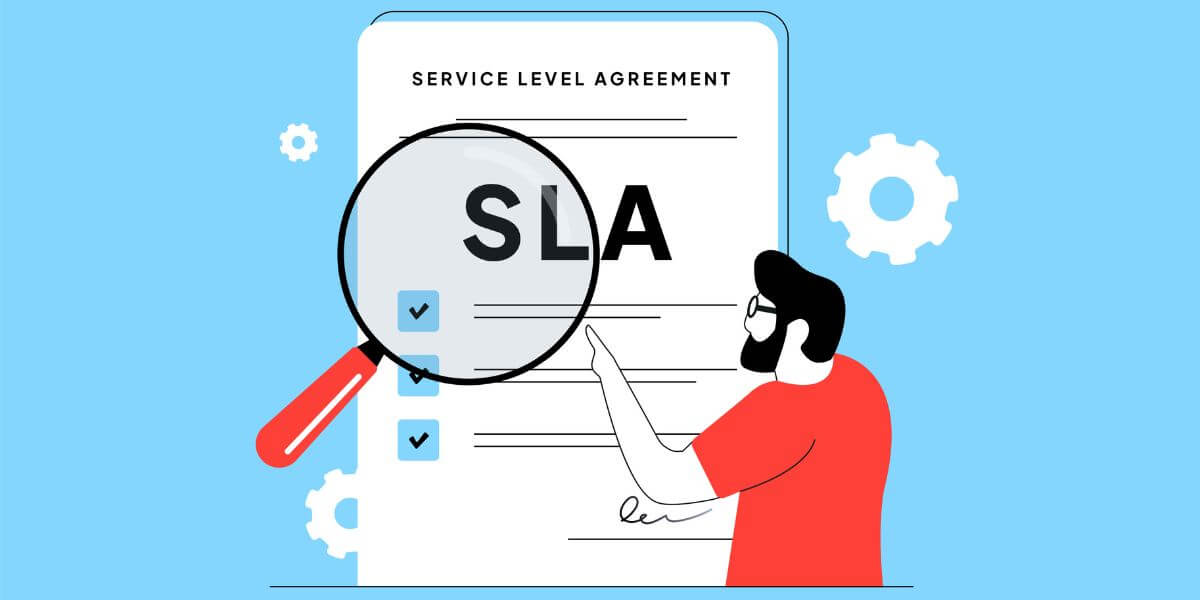Fiber Service Level Agreements (SLAs): What to Look For in the Contract
Table of Contents
Fiber Service Level Agreements (SLAs): What to Look For in the Contract
When businesses invest in fiber internet service, they’re not just paying for speed—they’re investing in reliability that keeps their operations running smoothly. However, even the most robust fiber networks can experience unexpected issues, from equipment failures to construction accidents.
This is where a fiber internet SLA becomes invaluable, serving as your safety net when service disruptions threaten your bottom line.
What is a Fiber Internet SLA?
A Service Level Agreement (SLA) is a contractual commitment between you and your internet service provider that defines specific performance standards and guarantees compensation when those standards aren’t met [1]. Think of it as insurance for your internet connection—while fiber internet is inherently more reliable than other connection types, SLAs provide financial protection and prioritized support when things go wrong.
Unlike basic service contracts that simply outline what you’ll receive, SLAs establish measurable metrics with real consequences. When your provider fails to meet uptime guarantees, response times, or performance benchmarks outlined in the SLA, you receive compensation, typically in the form of service credits or bill adjustments.
Why SLAs Matter for Business Internet
Today’s businesses depend on internet connectivity for everything from cloud applications to VoIP communications and online transactions. Even brief outages can result in lost revenue, decreased productivity, and damaged customer relationships. A comprehensive fiber internet SLA ensures that when service issues occur, your business isn’t left bearing the full financial burden.
SLAs also provide leverage in your relationship with internet providers. When you compare internet providers, those offering robust SLAs demonstrate confidence in their network reliability and commitment to customer satisfaction. This becomes particularly important when evaluating the best internet providers for your business needs, as SLA terms often distinguish premium providers from budget alternatives.
Key Components to Look for in Fiber Internet SLAs

Understanding SLAs
SLAs are a critical factor to consider when selecting a reliable fiber internet provider. Here are some key components to look for in SLAs:
Network Uptime Guarantees
The most important element of any fiber internet SLA is the uptime guarantee, typically expressed as a percentage. Industry-standard SLAs usually guarantee 99.9% uptime, which allows for approximately 8.8 hours of downtime per year. However, premium business services often offer 99.99% uptime guarantees, reducing acceptable downtime to just 52 minutes annually.
When reviewing uptime commitments, pay attention to how downtime is measured and what qualifies as an outage. Some providers exclude planned maintenance windows from their calculations, while others include all service interruptions. Understanding these definitions helps you make accurate comparisons when you compare internet plans from different providers.
Response and Resolution Times
Beyond uptime guarantees, SLAs should specify how quickly your provider will respond to service issues and work toward resolution. Response times typically range from 15 minutes to 4 hours depending on the severity of the issue and your service tier. Resolution times—how long repairs should take—vary more widely but should be clearly defined for different types of problems.
Look for SLAs that differentiate between various issue types. For example, a complete service outage might require a 2-hour response time with 8-hour resolution, while performance degradation might allow for longer response and resolution windows.
Performance Standards
Quality SLAs go beyond simple uptime metrics to include performance guarantees for latency, packet loss, and jitter. These metrics are particularly important for businesses using real-time applications like video conferencing, VoIP systems, or cloud-based software.
Typical performance standards in business fiber SLAs include latency under 20 milliseconds for local connections, packet loss below 0.1%, and minimal jitter variation. These specifications ensure your internet connection maintains the quality necessary for demanding business applications.
Compensation Structure
Perhaps the most practical aspect of any SLA is understanding exactly what compensation you’ll receive when service levels aren’t met. Most providers offer service credits calculated as a percentage of your monthly bill, with the credit amount increasing based on the severity and duration of the service failure.
Common compensation structures include daily credits equal to 1/30th of your monthly fee for each day of qualifying downtime, or percentage-based credits that escalate with longer outages. Some premium SLAs offer additional compensation for extended outages that significantly impact business operations.
Red Flags to Avoid in SLA Contracts
Being aware of potential pitfalls in SLA contracts can help you avoid unfavorable terms and ensure reliable service delivery.
Overly Complex Exclusions
While some exclusions are reasonable—such as outages caused by natural disasters or customer equipment failures—be wary of SLAs with extensive exclusion lists. Providers who exclude too many scenarios from their SLA coverage may not offer the protection you’re paying for.
Watch for exclusions related to peak usage periods, maintenance windows that aren’t properly scheduled, or vague language about “circumstances beyond our control." These broad exclusions can significantly limit when SLA protections apply.
Difficult Claim Processes
Some providers make SLA claims unnecessarily complicated, requiring extensive documentation or imposing unrealistic reporting timeframes. The best internet providers make claiming SLA credits straightforward, often providing automatic credits when monitoring systems detect qualifying outages.
Review the claim process carefully and ask about typical processing times. If claiming compensation requires jumping through multiple hoops or waiting months for resolution, the SLA may not provide practical value when you need it most.
Inadequate Monitoring and Reporting
Effective SLAs require robust monitoring systems that accurately track performance metrics. Providers should offer detailed reporting that allows you to verify SLA compliance and understand your network’s performance trends.
Be skeptical of providers who can’t demonstrate comprehensive monitoring capabilities or won’t commit to providing regular performance reports. Without proper monitoring, it becomes difficult to verify whether SLA standards are being met or to document qualifying incidents.
Questions to Ask When Comparing SLA Options

What to ask
When you compare internet providers and their SLA offerings, consider asking these essential questions:
- “How is network uptime calculated, and what events are excluded from uptime measurements?" Understanding the methodology behind uptime calculations helps you make accurate comparisons between different providers’ guarantees.
- “What specific performance metrics are guaranteed, and how are they measured?" Beyond basic uptime, comprehensive SLAs should address latency, packet loss, and throughput performance with specific measurement criteria.
- “How quickly will support respond to different types of service issues, and what escalation procedures are in place?" Response times should be clearly defined with escalation paths for issues that aren’t resolved within initial timeframes.
- “What compensation will you receive for different types and durations of service failures?" Understanding the compensation structure helps you evaluate the financial protection each SLA provides.
Making the Right Choice for Your Business
When searching for the best internet in your area, SLA terms should be a significant factor in your decision-making process. While internet prices and basic service features are important, the financial protection and service guarantees provided by a comprehensive SLA can save your business thousands of dollars during service disruptions.
Consider your business’ specific needs when evaluating SLA options. Companies that depend heavily on internet connectivity for revenue-generating activities may benefit from premium SLAs with stricter uptime guarantees and faster response times, even if they come at a higher cost.
For businesses with some tolerance for occasional outages, standard SLAs may provide adequate protection at a more reasonable price point. The key is understanding your risk tolerance and choosing an SLA that aligns with your business requirements and budget.
Ensuring Success Through the Right SLA Choice

The best SLAs for you
A well-structured fiber internet SLA serves as crucial protection for businesses that depend on reliable connectivity. When evaluating providers and conducting an internet comparison, pay close attention to SLA terms alongside traditional factors like speed and pricing.
The best internet providers stand behind their services with comprehensive SLAs that include meaningful uptime guarantees, rapid response times, clear performance standards, and fair compensation structures. By understanding what to look for in SLA contracts and avoiding common pitfalls, you can ensure your business gets the protection it deserves from its internet service investment.
Don’t let your business become another casualty of unexpected internet outages. Choose a provider whose SLA demonstrates their commitment to keeping your business connected and compensates you fairly when service falls short of expectations.
Sources
[1] TechTarget. “What is a service-level agreement (SLA)?"












 Call
Call 

 Access Your Account
Access Your Account